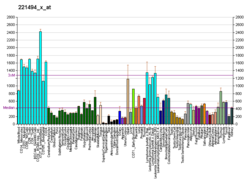| EIF3K | |||||||||||||||||||||||||||||||||||||||||||||||||||
|---|---|---|---|---|---|---|---|---|---|---|---|---|---|---|---|---|---|---|---|---|---|---|---|---|---|---|---|---|---|---|---|---|---|---|---|---|---|---|---|---|---|---|---|---|---|---|---|---|---|---|---|
| |||||||||||||||||||||||||||||||||||||||||||||||||||
| Identifiers | |||||||||||||||||||||||||||||||||||||||||||||||||||
| Aliases | EIF3K , EIF3-p28, EIF3S12, HSPC029, M9, MSTP001, PLAC-24, PLAC24, PRO1474, PTD001, ARG134, eukaryotic translation initiation factor 3 subunit K | ||||||||||||||||||||||||||||||||||||||||||||||||||
| External IDs | OMIM: 609596; MGI: 1921080; HomoloGene: 8292; GeneCards: EIF3K; OMA:EIF3K - orthologs | ||||||||||||||||||||||||||||||||||||||||||||||||||
| |||||||||||||||||||||||||||||||||||||||||||||||||||
| |||||||||||||||||||||||||||||||||||||||||||||||||||
| |||||||||||||||||||||||||||||||||||||||||||||||||||
| |||||||||||||||||||||||||||||||||||||||||||||||||||
| |||||||||||||||||||||||||||||||||||||||||||||||||||
| Wikidata | |||||||||||||||||||||||||||||||||||||||||||||||||||
| |||||||||||||||||||||||||||||||||||||||||||||||||||
Eukaryotic translation initiation factor 3 subunit K (eIF3k) is a protein that in humans is encoded by the EIF3K gene. [5] [6] [7]







